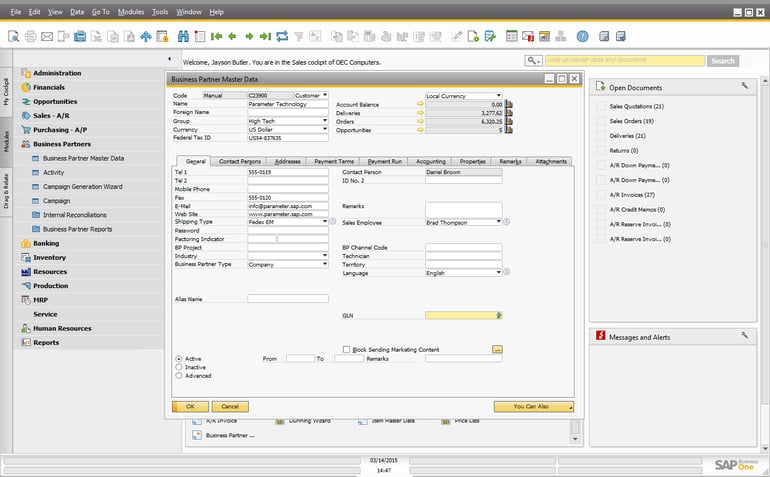 Are basic business functions holding you back?
Are basic business functions holding you back?
For many growing organizations, the very systems designed to keep things running smoothly can start to feel like roadblocks. When sales, finance, inventory, and customer service all operate on separate platforms, the result is often wasted time, duplicate data entry, and frustrating miscommunications. These inefficiencies are particularly common for small and midsize businesses navigating growth. If this sounds familiar, you’re not alone — and it’s often the first sign that it’s time to explore a true Enterprise Resource Planning (ERP) solution.
Consider some of the most common challenges we hear from businesses ready for an upgrade:
- Miscommunication between departments. Teams can’t see the same data in real time, leading to errors and delays.
- Difficulties in responding to customer data requests. Without centralized data, even simple inquiries can become a headache.
- Problems with managing inventory. Out-of-stock issues or over-purchasing eat into margins and frustrate customers.
These are all great reasons to consider an Enterprise Resource Platform (ERP).
Why Modern Businesses Choose ERPs
ERPs help a business improve collaboration, production, and efficiency. By breaking down data silos, companies gain real-time visibility and the ability to automate repetitive tasks. Many are housed in the cloud; secure and robust, the cloud allows large file storage and the ability to access the ERP via the “Internet of Things” (IoT).
If a business is seeking a software partner that will integrate crucial business functions from sales and inventory management to payroll and accounting, then they’re probably ready for an ERP.
With a well-implemented ERP, companies can:
- Auto-populate data across multiple business functions, reducing manual entry.
- Keep compliant with the latest financial, tax, and regulatory requirements.
- Gain a single source of truth for reporting and analytics.
- Streamline HR processes like time tracking, payroll, and workforce planning.
Core ERP capabilities typically include:
- Finance, accounting, and banking.
- Lead generation, sales (including order entry), and customer relationship management (CRM).
- Inventory and purchasing.
- Vendor management.
- Human resources, time tracking, and payroll.
- Reporting and business analytics.
The best ERPs integrate all these features into one interoperable platform. Ultimately, ERP platforms are business management tools designed for companies that are expanding their reach. Typically, these companies want to improve their workflows in order to gain more customers, reduce time spent on back office functions, and use analytics to improve profit. ERPs also allow remote functioning, typically from any digital device, which is crucial in today’s business landscape.
If a business is ready to compare ERPs, it will be easy to bog down in all the functional features.
For organizations comparing solutions, two names frequently rise to the top: Microsoft Dynamics 365 Business Central and SAP Business One. Both are well-regarded mid-market ERP solutions, but they’re not identical in scope or capability. A Business Central vs.SAP Business One evaluation often comes down to which platform offers the flexibility, scalability, and ease of integration that aligns with long-term growth plans.
Let’s start with an apples-to-apples review of two of the leading ERPs in the market: Microsoft Dynamics vs. SAP Business One.
Microsoft Dynamics vs. SAP Business One – Side-by-Side Comparison

SAP first hit the American market when the company was purchased from an Israeli software development company approximately five years ago. They’ve been targeting small to medium sized companies but are struggling to play catch up to the international powerhouse that is Microsoft.
It’s a foregone conclusion that SAP doesn’t integrate as well with the Microsoft suite of office products, but they continue to work on that. SAP is most frequently used by small to medium sized IT companies, and thus has been designed with some more specific solutions tailored to that vertical market. Conversely, Microsoft Dynamics has been utilized across a wide variety of industries, from IT to healthcare, to food service and distribution. This makes for a more robust platform suited to a wider variety of settings.
Reporting and analytics work well on both platforms. However, Dynamics offers a wider array of reporting functions, changing how you slice and dice data with tools like SmartList Builder, Excel Report Builder, SharePoint integration, and Business Portals. SAP uses one add-on platform for analytics and reporting.
In a Business Central vs.SAP Business One discussion, this difference in reporting flexibility is significant. Business Central leverages Microsoft’s Power BI for advanced visualizations, predictive analytics, and interactive dashboards that can be embedded directly into workflows. This deep integration with the Microsoft ecosystem — including Excel and Teams — is a key advantage for companies already running Office 365 or Azure. SAP’s analytics capabilities, while solid, often require additional configuration and third-party tools to achieve the same level of dynamic reporting.
At first glance, the features lists for these two products look very similar. Microsoft Dynamics and SAP are both great ERP platforms, but Dynamics does have the advantage, right out of the gate, of more than 750 add-on solutions. SAP cannot boast these numbers, but has developed a number of vendor partnerships to fill functional gaps in scalability.
Scalability is, indeed, another point to consider in a Business Central SAP comparison. Business Central is designed for both SMBs and larger organizations, allowing businesses to start small and scale up seamlessly as their needs grow. SAP Business One, while capable, tends to hit performance and customization limitations sooner when organizations expand globally or require complex multi-entity financials.
Both platforms are fairly functional, targeting small and midsize companies experiencing accelerated growth. But this is where Microsoft Dynamics extends well past SAP: they can flex to handle the largest of enterprises across states and nations. SAP has a specific market niche, and they’re doing well there, but if a business is planning on expansive growth, Dynamics is probably the better long-term fit.
This is especially relevant for companies pursuing hybrid cloud deployments or AI-driven automation. Microsoft is continuously adding AI-powered Copilot capabilities to Business Central, enabling predictive insights and natural-language data queries — features SAP Business One does not yet match.
Both platforms feature rapid start out-of-the-box features, but Microsoft Dynamics has the benefit of the more familiar environment. Most Americans have been using Microsoft products for several years, so the dashboards and workflow processes have a more familiar feel. This is an advantage when it comes to user adoption of this platform.
SAP Business One today supports Windows and certain Linux environments, but lacks the extensive interoperability offered by Microsoft’s Business Central. Business Central is fully web-based, meaning it works across virtually all modern operating systems and devices, including mobile.
When comparing Business Central vs.SAP Business One, cross-platform compatibility and mobility are critical considerations. Business Central’s browser-based design and native mobile apps give teams the freedom to work from anywhere — a must-have in today’s hybrid work landscape. SAP Business One’s mobile experience is more limited, often requiring third-party apps to achieve similar functionality.
SAP Business One offers the standard interface with access to a variety of features for all users. Interestingly, Microsoft Dynamics allows immediate customization in workflows, dashboards, and task lists, offering 20 templates and views to select. This personalization is a refreshing standard feature across the Dynamics suite of products.
SAP does offer out-of-the-box workflow solutions that Dynamics does not, with the rather minor drawback that you will have to adjust your internal processes to SAP’s processes. But SAP lacks the ability to flex with a business that comes with the Microsoft product. Dynamics was designed with this flexibility in mind, so it can grow with your business, no matter what industry you’re in.
Business Central also integrates with modern tools like Microsoft Teams, Outlook, and Power Automate, allowing workflows to extend beyond the ERP platform itself. This seamless integration is a key differentiator in any Business Central SAP comparison, as it allows companies to automate tasks, approvals, and data sharing across all Microsoft 365 tools without additional customization.
General benefits of Microsoft Dynamics vs. SAP Business One to consider include:
- Deploying Microsoft Dynamics from the cloud increases efficiency and flexibility for managers of information technology.
- The upgraded window design of Microsoft Dynamics facilitates faster file sorting from one screen. You can track and view prior purchase orders; improve relationships and better manage vendors, and even set up custom filters highlighting your preferred search preferences.
- Dynamics boasts robust, immediate functionality and implementation options that are scalable to your business.
- Quick and simple configuration and customization makes Dynamics a good choice when the time from box to go live is important.
- One “neat feature” to mention is the budged exception reporting feature that flags accounts that aren’t setup system-wide.
- Multiple simultaneous order entry across sale, purchasing, human resources and other functions is possible, managed efficiently by workflow reassignment notifications that allow for better document control.
- In the sales module, there is an all-in-one document feature that allows concise review of all transactions by client in one single window.
Additionally, Business Central offers advanced AI and machine learning features such as cash flow forecasting, late payment predictions, and intelligent inventory replenishment suggestions. These capabilities aren’t fully matched in SAP Business One, which often relies on manual configurations or add-ons for similar functionality. For companies evaluating Business Central vs. SAP Business One, the ability to leverage these built-in AI tools can provide a faster ROI and better long-term scalability.
Security is another area where Microsoft Dynamics Business Central shines. Leveraging Microsoft’s Azure platform, Business Central benefits from enterprise-grade security protocols, data encryption, and automatic updates to keep systems compliant with evolving regulations. While SAP Business One offers solid on-premises security measures, its cloud capabilities and update cycles tend to lag behind Microsoft’s continuous improvement model.
But don’t take our word for it; let’s take a look at what businesses are saying about these two products.
Microsoft Dynamics vs. SAP Business One -- What Businesses Are Saying
Consumer reviews of Microsoft Dynamics vs. SAP Business One tell the story of one platform that is clearly accelerating the work world.
Microsoft Dynamics made Gartner’s “Magic Quadrant,” the IT equivalent of The People’s Choice Awards. Capterra ranks Microsoft Dynamics with 4.5 of 5 stars. Keystone Strategy conducted an extensive side-by-side field test of Microsoft Dynamics vs. SAP Business One in 2007, with some interesting results. Their evaluation looked specifically at the benefits of these platforms, and how users increased their productivity as a result of using these ERPs. They measured use of these ERPs across 100 businesses in the following areas:
- Collaboration and workflow efficiencies as an aid to inter-departmental communication.
- Business insight across departments, and ease of BI reporting.
- Flexibility in adapting the platform to changing business needs.
- Usability including overall UX (user experience).
- Familiarity and ease of learning and implementing the new platform.
- Transactional Efficiency including the system’s speed, reliability and effectiveness.
Their findings included:
- Actual users of Microsoft Dynamics scored the platform 18% higher than SAP users scored the SAP platform.
- While Microsoft Dynamics scored higher than SAP overall, the software was ranked as high as 27% better in some categories.
- Dynamics scored twice as high for finance functions as SAP.
In the following survey questions, SAP scored twice as high as Microsoft Dynamics. In this case, twice as high, meant twice as bad. Some of the survey questions included:
- It takes too long to learn how to work with this software.
- I sometimes don’t know what to do next with this software.
- This software is awkward when I want to do something that is not standard.
This side-by-side comparison of Microsoft Dynamics vs. SAP Business One has yielded a substantial argument for the benefits for Dynamics implementation. It seems fairly clear that Microsoft Dynamics offers the flexibility to get the job done right, while allowing the scalability to grow with your business. The familiarity of the Dynamics platform increases ease of use, interoperability between functions, with a more robust add-on offering. Of particular importance is the concept of “user friendliness;” software adoption will increase automatically and training time will lessen upon adoption of the more familiar software package.
Nucleus Research, a global provider of IT research, backed up these findings, publishing a report showing companies that use SAP ERP are 20% less profitable than businesses that use Microsoft Dynamics.
In more recent customer surveys, Microsoft Dynamics 365 Business Central consistently ranks above SAP Business One for ease of use, scalability, and integration with third-party applications. This reinforces what many businesses have found — Business Central is not just an ERP but part of a larger Microsoft ecosystem that supports growth, innovation, and analytics.
It’s also worth noting that Business Central continues to evolve at a rapid pace, with Microsoft’s annual release waves introducing new AI-driven features, improved e-commerce integration, and better multi-company financial consolidation. SAP Business One, while still supported, follows a slower development cycle, which can leave businesses waiting longer for key innovations. This difference can significantly influence long-term ROI in any Business Central SAP comparison.
While these findings are almost shocking in their comparison of Microsoft Dynamics vs. SAP Business One, ultimately, business owners will have to make their own decision when it comes time to adopt an ERP. When a business is ready to compare Microsoft Dynamics vs. Business One, IES can help you measure the on-the-ground ROI of these platforms, and aid you in selecting the best and most cost effective solution for your current and future daily business needs.
As a trusted Microsoft Dynamics 365 partner, IES specializes in guiding businesses through every step — from initial discovery to seamless implementation and ongoing support. Whether you’re evaluating Business Central vs. SAP Business One or need expert insight into customizing Business Central for your unique workflows, our team can help you build a scalable ERP strategy that grows with your organization. Contact IES today to schedule a consultation and see how Business Central can deliver more value than SAP Business One — now and in the future.



